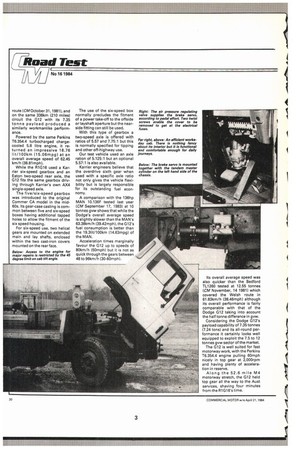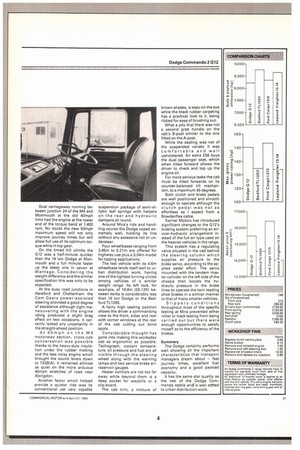A Dodge to dream of
Page 118

Page 119

Page 120

If you've noticed an error in this article please click here to report it so we can fix it.
Plated to take advantage of the recent vehicle excise changes, this 12-tonner possesses star quality, says Bryan Jarvis. Fast times, excellent fuel and good payload are evident THE RECENT Budget changes in vehicle excise duty have favoured one particular group of heavy goods vehicles, those two-axled rigids which range from 7,5 to a maximum of 12 tonnes.
Because the rate of £290 per annum remains constant across this band, Karrier Motors feels that it will become an important sales sector, allowing its Commando 2 G12 plated at 12 tonnes gvw to take full advantage of the new ved rates.
The vehicle has been available since June last year but has sold only in small numbers, 53 in all mainly to local authorities and public utilities.
Since the Budget, the significance of its gvw limit and carrying capacity has taken on a new importance.
At 16 tonnes gvw on a previous road test the Dodge R1G16 set new economy standards around our Welsh test route (CM October 31, 1981), and on the same 338km (210 miles) circuit the 012 with its 7.35 tonne payload produced a similarly workmanlike performance.
Powered by the same Perkins 16.354.4 turbocharged chargecoded 5.8 litre engine, it returned an impressive 113.76 lit/100km (1 5.06mpg) at an overall average speed of 62.45 km/h (38.81 mph).
While the R1016 used a Karrier six-speed gearbox and an Eaton two-speed rear axle, the G12 fits the same gearbox driving through Karrier's own AX4 single-speed axle.
The five/six-speed gearbox was introduced to the original Cammer CA model in the mid60s. Its gear-case casting is common between five and six-speed boxes having additional tapped holes to allow the fitment of the six speed housing.
For six-speed use, two helical gears are mounted on extended main and lay shafts, enclosed within the two cast-iron covers mounted on the rear face. The use of the six-speed box normally precludes the fitment of a power take-off to the offside or layshaft aperture but the nearside fitting can still be used.
With this type of gearbox a two-speed axle is offered with ratios of 5.57 and 7.75:1 but this is normally specified for tipping and other off-highway use.
Our test vehicle used an axle ration of 5.125:1 but an optional 5.57:1 is also available.
Karrier engineers believe that the overdrive sixth gear when used with a specific axle ratio not only gives the vehicle flexibility but is largely responsible for its outstanding fuel econnomy.
A comparison with the 136hp MAN 10.136F tested last year (CM September 17, 19831 at 10 tonnes gvw shows that while the Dodge's overall average speed is slightly slower than the MAN'S 63.38km/h (39.42mph), the G12's fuel consumption is better than the 19.31it/100km (14.63rnPg) of the MAN.
Acceleration times marginally favour the G12 up to speeds of 80kmth (50mph} but it is not as quick through the gears between 48 to 96kmih (30-60mph). Its overall average speed was also quicker than the Bedford TL1260 tested at 12.55 tonnes (CM November, 14 19811 which covered the Welsh route in 61.83km/h (38.46mph) although its overall performance is fairly comparable with that of the Dodge 012 taking into account the half tonne differance in gvw. Considering the Dodge 012's payload capability of 7.35 tonnes (7.24 tons} and its all-round performance it certainly looks well equipped to exploit the 7.5 to 12 tonnes gvw sector of the market. The 012 is well suited for fast motorway work, with the Perkins T6.354.4 engine pulling 60mph nicely in top gear at 2,000rpm and having plenty of acceleration in reserve.
Along the 52.6 mile M4 motorway stretch, the G12 held top gear all the way to the Aust services, shaving four minutes from the R1G16's time. Dual carriageway running between junction 24 of the M4 and Monmouth at the old 40mph limit had the engine at the lower end of the torque band at 1,400 rpm. No doubt the new 50mph maximum speed will not only improve journey times but will allow full use of its optimum torque while in top gear, On the timed hill climbs the G12 was a half-minute quicker than the 16 ton Dodge at Monmouth and a full minute faster up the steep one in seven at Wantage. Considering the weight differance and the similar specification this was only to be expected.
At the busy road junctions in Hereford and Cheltenham the Cam Gears power-assisted steering provided a good degree of assistance although tight maneouvering with the engine idling produced a slight drag effect on two occasions. It certainly lacked any uncertainty in the straight-ahead position.
At 6 0 mph on the M4 motorway section, cross-cab conversation was possible thanks to the heavy-duty insulation under the rubber matting and the less noisy engine which brought the sound levels down to 72dB(A). It remained allmost as quiet on the more arduous 40mph stretches of road near Abingdon.
Another factor which helped provide a quieter ride was its conventional yet very capable suspension package of semi-elliptic leaf springs with helpers on the rear and hydraulic dampers all round.
Around Mira's ride and handling course the Dodge coped extremely well, holding its line without any excessive roll or understeer.
Four wheelbases ranging from 3.45m to 5.21m are offered for highway use plus a 3,04m model for tipping applications.
The test vehicle with its 4.6m wheelbase lends itself well to urban distribution work, having one of the tightest turning circles among vehicles of a similar weight range. Its left lock, for example, of 16.8m (55.12ft) between kerbs is considerably less than 16 ton Dodge or the Bedford 111260.
A fairly high seating position allows the driver a commanding view to the front, sides and rear with corner windows at the rear of the cab cutting out blind spots.
Considerable thought has gone into making this workaday cab as ergonomic as possible. Tachograph, coolant temperature, oil pressure and fuel are all visible through the steering wheel along with the warning lamps and two service brake airreservoir gauges.
Heater controls are not too far away while beyond them is a deep pocket for waybills or a clip-board.
The cab trim, a mixture of brown shades, is easy on the eye while the black rubber carpeting has a practical look to it, being ribbed for ease of brushing out.
What a pity that there was not a second grab handle on the cab's 8-post similar to the one fitted on the A-post.
While the seating was not of the suspended variety it was comfortable and well upholstered. An extra £56 buys the dual passenger seat, which when tilted forward allows the driver to check and top up the engine oil.
For more serious tasks the cab must be tilted forwards on its counter-balanced tilt mechanism, to a maximum 45 degrees.
Both clutch and brake pedals are well positioned and smooth enough to operate although the clutch pedal was not as effortless as I expect from a Bowdenflex cable.
Karrier Motors has introduced significant changes to the G12's braking system preferring an airover-hydraulic arrangement instead of the full-air type used on the heavier vehicles in the range.
This system has a regulating valve situated in the cab behind the steering column which supplies air pressure to the brake servo, according to the applied pedal effort. The servo mounted with the tandem master cylinder on the left side of the chassis then boosts the hydraulic pressure in the brake lines to operate the twin leading shoe brakes in a similar manner to that of many smaller vehicles.
Slippery conditions throughout most of the specific testing at Mira prevented either roller or track testing from being carried out but there were enough opportunities to satisfy myself as to the efficiency of the brakes.
Summary The Dodge certainly performs well showing all the important characteristics that transport managers dream about fast journey times, excellent fuel economy and a good payload capacity.
It has the same star quality as the rest of the Dodge Commando stable and is well satted to urban distribution work.




























































































































































































